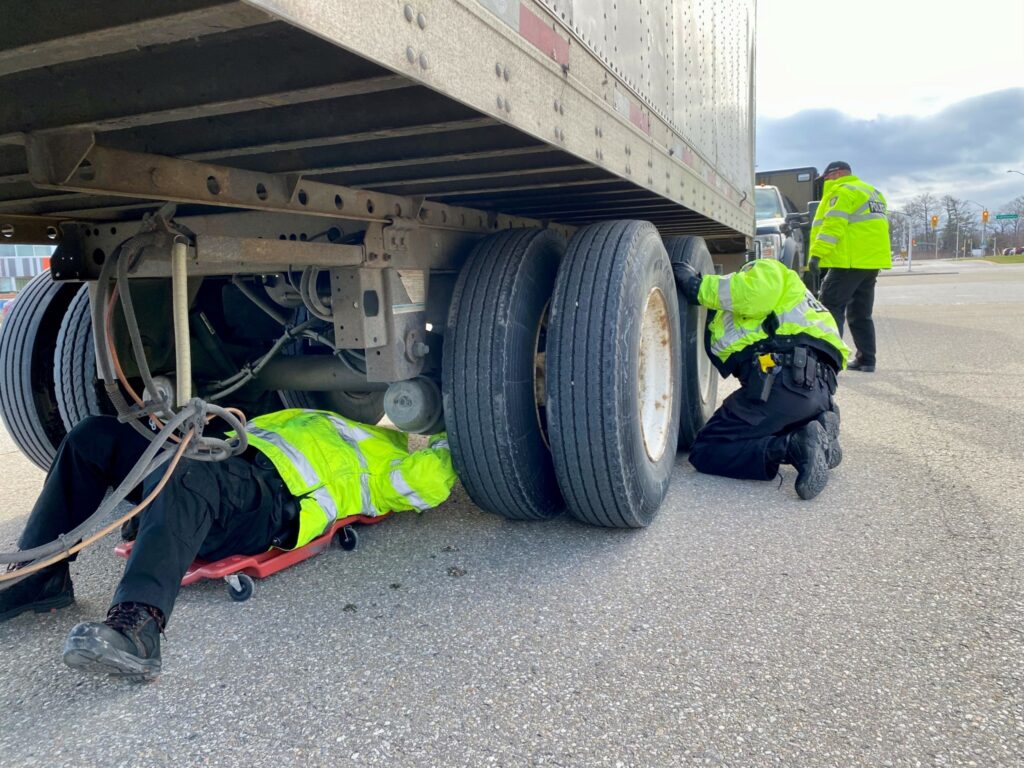Training, safety investments prevent violations
Some people like BLT – bacon, lettuce and tomato – in their sandwich. Commercial carrier folks may not find it to their taste, especially when talking about BLT (brake, light and tire) violations.
For the past few years, Commercial Vehicle Safety Alliance’s (CVSA) International Roadcheck campaigns have continued to find the most violations with brakes, lights and tires, and this year’s blitz on May 16-18 is approaching quickly.
Last year, Canadian enforcement teams placed 22.6% of inspected vehicles out of service during a May 17-19 campaign. The top five vehicle out-of-service violations involved brake systems, cargo securement, defective service brakes, lights and tires.
It is easy to point fingers at the driver, but safety is everyone’s responsibility, Chris Harris from Safety Dawg said during the Fleet Safety Council Hamilton Niagara Chapter’s annual spring seminar in Burlington, Ont.

If a company’s violations are repetitive, at a basic level, it is a problem with the pre-trip inspection, added Bonnie Learn, from Northbridge Insurance.
Get into the habit of looking at, and properly inspecting, equipment advised Michael Derry from Summit Risk Solutions. Bad habits are sometimes allowed to continue by people in authority at a carrier, he added.
There should be consequences if violations or defects are found by enforcement officers, said Bud Kneller of Frontline Commercial Vehicle Solutions.
Business implications
Derry noted that customers have access to a carrier’s profile and would like to do business with safe companies. That could be the factor securing a contract or bid. Equipment is also more expensive to fix on the road than in the yard, so a safety culture saves money, he said.
Kneller added that shippers want to work with carriers that have a good safety record and who are therefore less likely to be involved in a lawsuit.
Drivers always talk to one another about the companies they work for, Learn said. They wouldn’t want to work for a carrier whose trucks are constantly pulled over at scales due to violations. Also, an existing employee will leave you for a safer fleet, she added.
Sales tool
Trucking is a very competitive industry. On a positive note, companies can use their safety profile as a sales tool when looking to secure business. Show a shipper your safety rating, how much time is spent on the road and not at inspection scales or sitting on the side of the road waiting for repairs, Derry said.
Learn said insurers are always impressed with documentation that proves a safety culture and shows that policies are in place to maintain it. It is important to share the scores with drivers and the shop, she added.
A carrier’s profile can affect insurance premiums by plus or minus 10%, said Harris.

Drivers appreciate transparency, so share CVOR details and the safety management system. Explain to drivers how their actions affect the CVOR and the carrier, Harris added.
Seminar moderator John Farquhar from Summit Risk Solutions said you cannot manage what you do not measure so it is key to monitor performance to prevent future violations.
Harris said a key measurement is number of accidents or crashes per million miles. The data should be made available to drivers.
Ownership support
Another measurement is recruiting and retention numbers, Learn said. Safety costs money and tracking must have support of ownership and senior management.
Reward drivers who have fewer hard braking incidents and are fuel efficient, said Harris. It means they have good driving habits, including better following distances.
Policies need to be in place to ensure that people who flow through a position can follow them to maintain standards, Derry said.
Kneller said everyone should be present during driver meetings. It is easier to point fingers when a person is not around. But when all are in the room, he said, there is a good dialogue and solutions are found.
Have your say
This is a moderated forum. Comments will no longer be published unless they are accompanied by a first and last name and a verifiable email address. (Today's Trucking will not publish or share the email address.) Profane language and content deemed to be libelous, racist, or threatening in nature will not be published under any circumstances.
I didn’t know that you were in the audience Leo. Thanks for covering the event.
As the new safety supervisor at my company this information was on point and very useful thank you very much
Great information, excellent article.
The great presentation yesterday in Burlington by the Fleet Safety Council of Hamilton/Niagara was informative and entertaining.. You captured the essence of the presentation perfectly, Leo. An excellent panel that represented the different views and angles of safety and all with a wealth of knowledge and experience. John was a great moderator, and the camaraderie between the panelists was evident. I took some great ideas away to implement into our Safety Program.